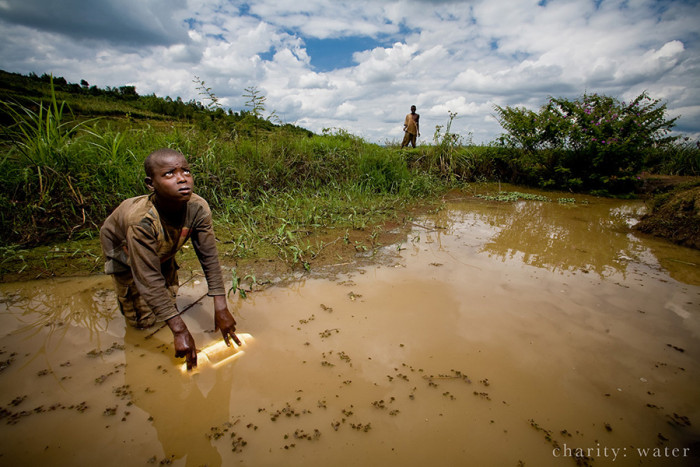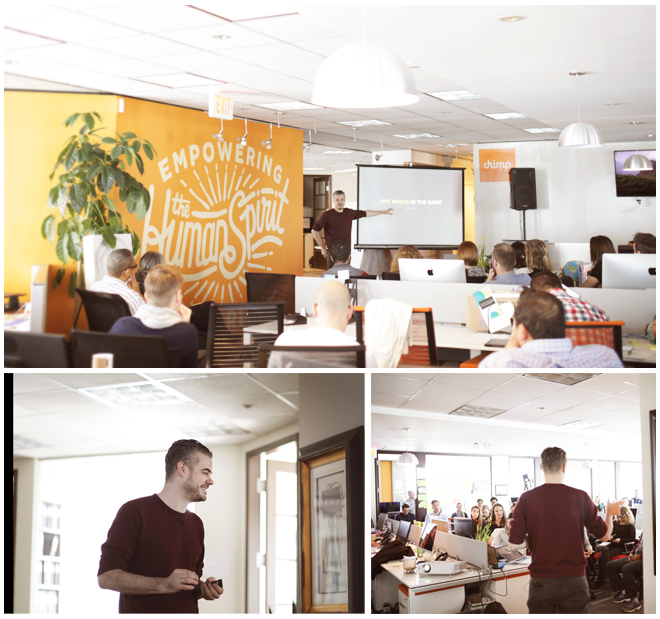5 Ways charity: water Is Redefining Charity
March 18, 2015
5 min read
We recently had the pleasure of welcoming Scott Harrison (above, right) into the Chimp offices. The founder and CEO of charity: water, the New York-based charity working to bring clean water to developing nations, shared details about his charity’s unique approach, and how that has led to its success.
[tw-column width=”three-fifth”]
Launching charity: water
In 2006, after two years of volunteer humanitarian work in Africa, Harrison was struck by the fact that clean water, something we take for granted in North America, was so inaccessible in the Third World. So he set out to change that.
“I thought clean water was one of the few things everyone in the world could agree on,” Harrison said. “If we can bring clean water to 750 million people, we’ll know we’ve made an impact.”
[/tw-column]
[tw-column width=”two-fifth” position=”last”]
The Backstory on charity: water
If you aren’t familiar with Scott Harrison’s story, he’s the good Christian kid turned club promoter who lost his way in the vice-laden nightlife of New York City.
“I came to my senses at 28,” he said. “I started reading theology and tried to find a way back to the morality I had lost.”
After volunteering with Mercy Ships for two years, Harrison turned his attention to the lack of clean drinking water in Third World countries.
“Forty-five hundred kids die every day from bad water,” he said. “Half of the world’s schools don’t have clean water. Over 200 million people have worms because of the water they drink.” Read his full story.
[/tw-column]He launched charity: water with two objectives: to bring clean water to the world by way of freshwater wells, rainwater catchments and sand filters, and to reinvent charity. In both endeavours, he is succeeding.
5 Ways charity: water Is Changing Charity
From the beginning, Harrison’s approach to creating and growing charity: water has been unconventional. With his background in the entertainment industry, Harrison took a decidedly sexier approach to charity than has been the norm in the sector. “My friends had a litany of excuses for not giving,” he said. “People didn’t trust how charities handled their money.”
“I wanted to create a new model to get people excited about giving.”
He started with a birthday party, encouraging his friends to give $20 instead of presents, and raised $15,000 for a refugee camp in Northern Uganda. He then sent proof of the project to all 700 people who had donated. “They were blown away to know where their $20 went,” he said. “By showing donors their impact, you rebuild trust.”
Harrison expanded the birthday concept, building tools to allow charity: water supporters to fundraise. “In the first month, 92 people donated their birthdays,” he said.
His approach worked. For the first five years, charity: water experienced 90% year-over-year growth at a time when charitable giving in America was down overall. It’s raised $170 million in total and has helped 5 million people get access to clean water so far.
Here Harrison shares some of the strategies that have propelled charity: water’s growth and success.
1. Social First
charity: water uses social networks to tell stories, share content and build an audience. It now has 44 million followers on Twitter, 303,000 Likes on Facebook and 227,000 followers on Instagram. It’s also experimenting with newer platforms like Snapchat to reach younger audiences. Its first drilling rig, Yellow Thunder, even has its own Twitter feed and tweets whenever it starts drilling in a new location.
“We’ve never mailed anyone anything. I would never mail a cheque, so we jumped on social platforms to create new ways to connect with our community. We’re awesome storytellers, and people want to see things happening in real time.”
2. The 100% Model
With increasing donor distrust of overhead costs, charity: water decided to give 100% of donations to its water projects, and find an alternate way of covering overhead.
“We built a private giving program called The Well and got other people to believe in us.”
The Well is exclusively designed to fund overhead costs, and currently includes 104 donors on a 3-year commitment, with donations starting at $60,000. Its donors list includes people who work at Facebook and Toms, the band Depeche Mode, along with a variety of celebrities committed to the cause.
3. Technology-powered Transparency
From the beginning, charity: water has diligently informed donors about both its successes and its failures, using a combination of online tools like Google Maps and Google Earth, and sophisticated on-location tracking devices to monitor progress in real time.
“We use technology to show people where their money goes. We train local partners to prove the water point they’ve built.”
4. Design-centred Approach
charity: water’s communications are sleek and compelling, leaning heavily on quality visuals. Everything is intentionally designed to attract media-savvy donors.
“I started asking myself why products are peddled with more sophistication than life-saving causes. You don’t need money to do this, you just need good taste, beautiful creative and skilled designers.”
5. Local Partners
Aside from the 70 people working at its New York City headquarters, charity: water only employs locals to power its global initiatives on-location on a day to day basis.
“We employ 1,500 people around the world. And we tell their stories.”
Want to help charity: water bring clean water to 750 million people around the world? Give to our Canadian Friends of charity: water Giving Group.


